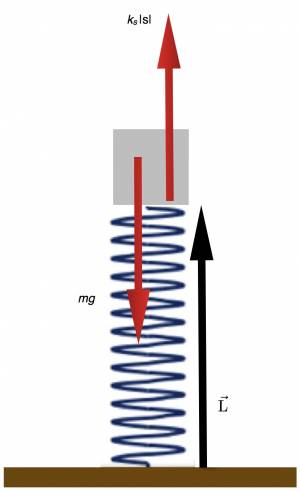This is an old revision of the document!
Example: Predicting the motion of a system that is subject to a spring interaction
A spring has a relaxed length of (0.2m) and it has a spring constant of 8 N/m. Attached to the top of the spring is a block of mass (.06)kg. A force is exerted on the block to compress the spring to a total length of (0.2m). Predict the y position for the graph after 0.1 second and 0.2 seconds.
Facts
- Spring has relaxed length of (0.2m) $L_0=0.2m$
- Spring has compressed length of (0.1m) $|\vec{L}| = 0.1m$
- Spring has spring constant of $8 N/m$
- Block of mass (.06)kg attached to top of the spring
- $\vec{p_i} = \langle 0,0,0 \rangle$
- Two forces acting on the spring = the gravitational force and the spring force
Lacking
Approximations & Assumptions
- Assume block is at rest when released from compressed position therefore initial momentum of block is zero
- Approximate that the origin is at the base of the spring
- Over the time interval investigated drag forces are negligible.
Representations
- The force of the spring is given by $F_{spring} = -k_s |vec{L}| - L_0 hat{L}$
- The gravitational force is given by $F_{Earth}=-mg$
- The momentum of the system is given by $\vec{p_f}=\vec{p_i}+\vec{F_{net}} \Delta t$
Solution
Set-up force equations for both spring and force due to gravity
$\vec{L}=\langle 0,0.1,0 \rangle - \langle 0,0,0 \rangle = \langle 0,0.1,0 \rangle m$
$\vec{|L|}=0.1$
$\hat{L}=\langle 0,1,0 \rangle$
$F_{spring} = -k_s(|\vec{L}|-L_0)\langle 0,1,0 \rangle = \langle 0,-k_s(|\vec{L}|-L_0),0 \rangle$
$F_{Earth} = \langle 0,-mg,0 \rangle$
The initial momentum of the block is zero, since you approximate that it is at rest when you release it
$\vec{p_i}= \langle 0,0,0 \rangle$
All of the forces acting on the system by the spring and gravitational force are in the y direction, and the initial x and z components of the blocks momentum are zero, so we only need to consider the y components of forces.
$F_{spring} = -k_s(|\vec{L}|-L_0)\hat{L}$
$F_{Earth}=-mg$
$F_{net,y} = F_{spring,y} + F_{Earth,y}$
For 0.1 seconds
$\vec{|L|} = 0.1m$
$s = 0.1m - 0.2m = -0.1m$
$F_{spring_y} = -8N/m(-0.1m)= +0.8N$
$F_{Earth,y} = -0.06kg x 9.8N/kg = -0.588N$
$F_{net,y} = .212N$
$p_{fy} = 0 + (.212N)(0.1s)\quad(Momentum\ Principle)\\$
$p_{fy} = 0.0212 kg * m/s$
$v_{avg,y} \approx v_{fy}$
$v_{fy} = \dfrac{p_{fy}}{m} = \dfrac{0.0212 kg * m/s}{0.06kg} = +0.353m/s$
$y_f = 0.1m + (0.353m/s)(0.1s) \quad(position\ update)\\$
$y_f = 0.135m \quad(position\ in\ y\ direction\ after\ .1s)\\$
For the time of 0.2s
$\vec{|L|} = 0.135m$
$s = 0.135m -0.2m = -0.0647m$
$F_{spring,y} = +0.520N$
$F_{net,y} = -0.0707N$
$p_{fy} = (0.0212 kg * m/s) + (-0.0707N)(0.1s)$
$p_{fy} = 0.0141 kg * m/s$
$v_{fy} = 0.236 m/s$
$y_{f} = 0.159m \quad(position\ in\ y\ direction\ after\ .2s)\\$
